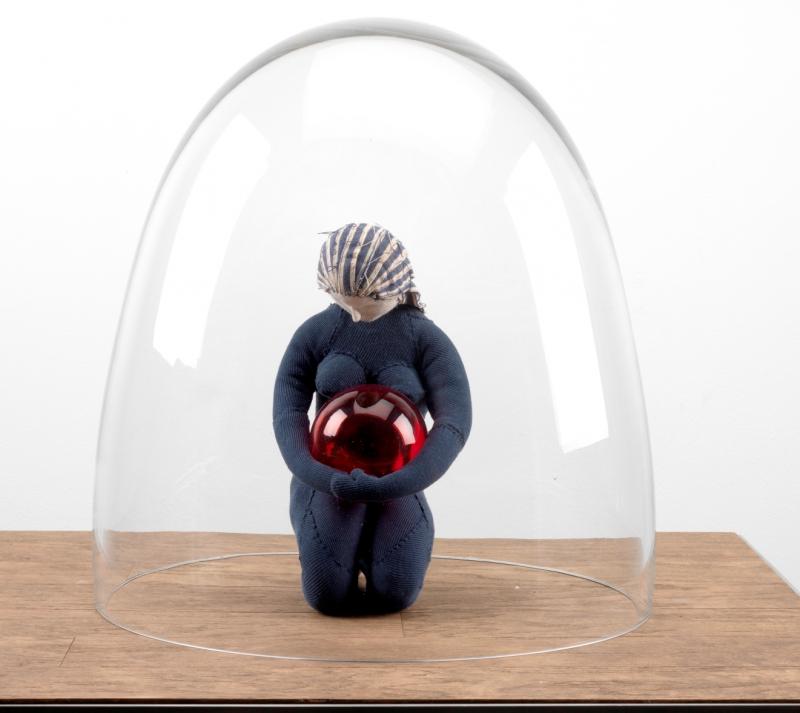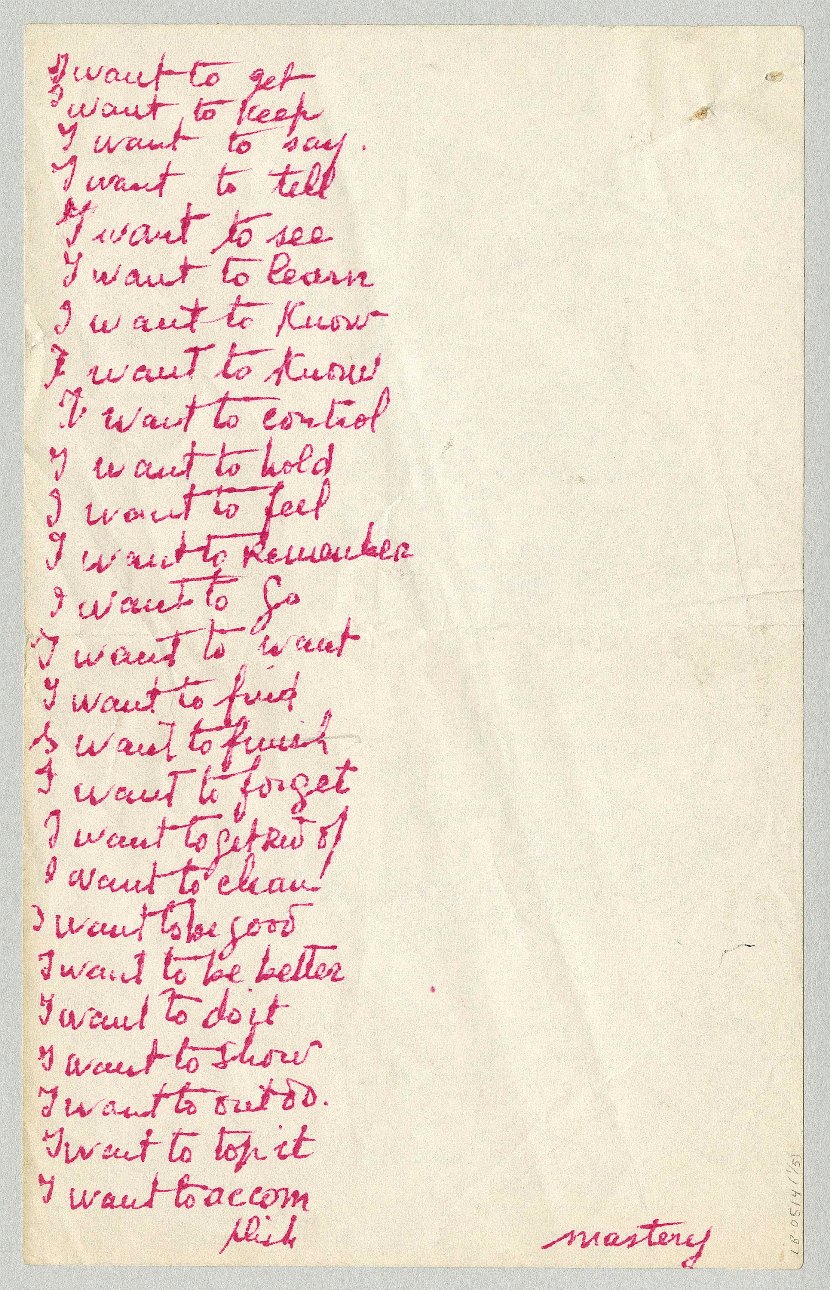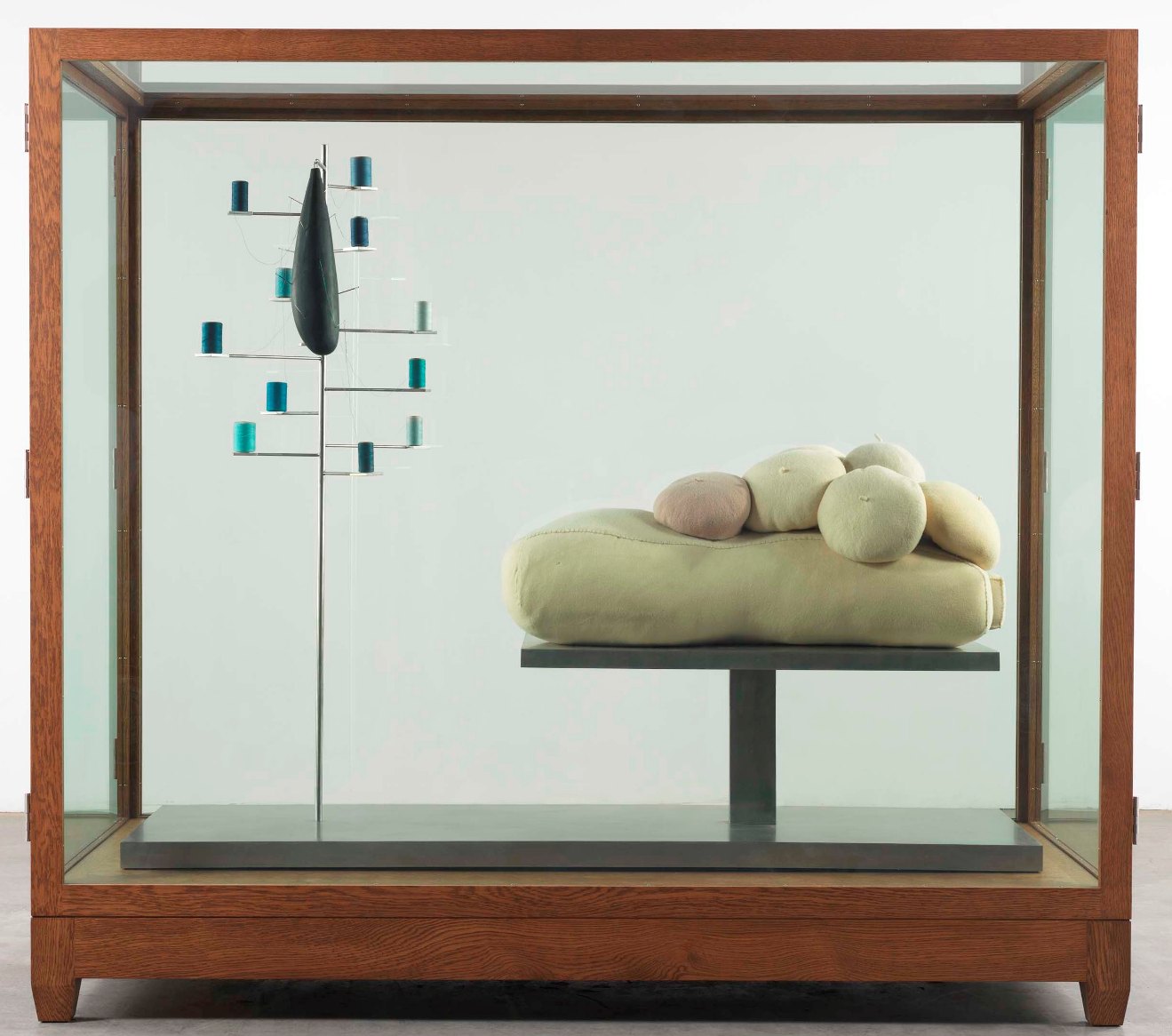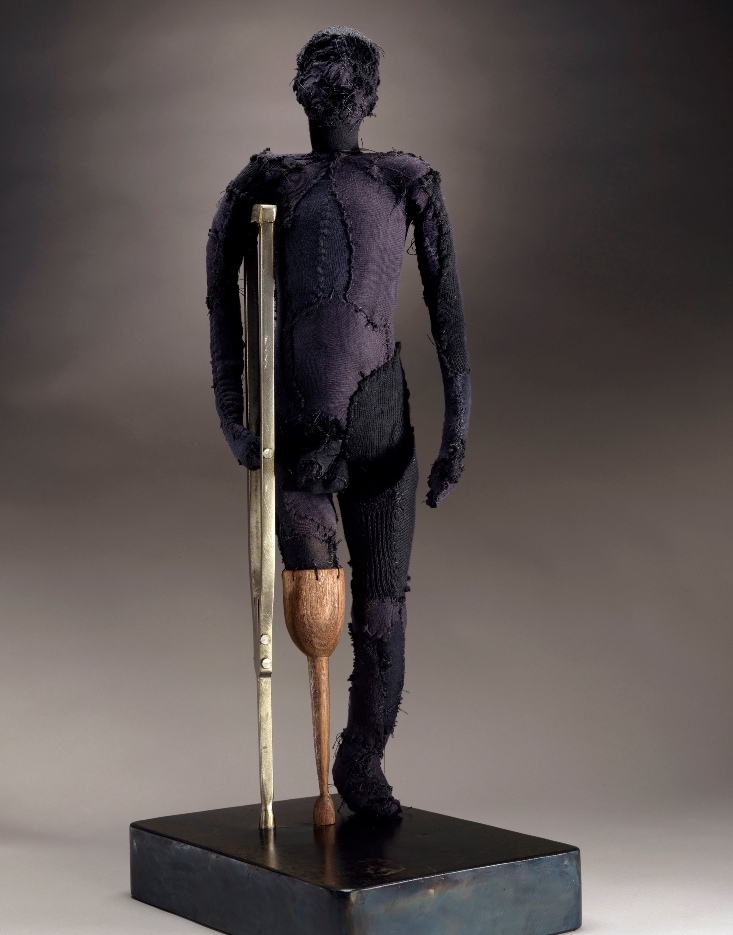Louise Bourgeois: The Return of the Repressed, Freud Museum | reviews, news & interviews
Louise Bourgeois: The Return of the Repressed, Freud Museum
Louise Bourgeois: The Return of the Repressed, Freud Museum
The artist's psychoanalytic writings frame works obsessed with psychic trauma

Louise Bourgeois tirelessly, obsessively documented her 32 years of psychoanalysis.
But since the discovery of her psychoanalytic writings (two boxes discovered in 2004, and two just after her death, aged 98, in 2010) some rather big claims have been made for them: they must surely take their place, says her literary executor Phillip Larratt-Smith, alongside the autobiography of Cellini, the journals of Delacroix and the letters of Van Gogh. Maybe so, and a two-volume monograph will shortly be published that contains a selection, but on the basis of what is featured at the Freud Museum, maybe not, and in any case, it’s rather difficult to read them all as they are presented here, on the walls and framed and placed in glass vitrines.
 “I am sixty two years old and I have dragged myself from day to day, the result of an anxiety that only work as a sculpture has appeased”, she begins on one closely scrawled leaf. On another, perhaps a little more prosaically, she lists seven ways to “end it all”, whilst another, longer list (pictured right) a certain self-obsessive petulance makes itself apparent beneath the anguish: “I want to get/I want to keep/I want to say/I want to feel/I want to see/I want to learn”, and so it goes on, rather tediously, until we get to the final word, presented as if it might, in an ideal world that can never exist, be the sum total of demands fulfilled – “mastery”.
“I am sixty two years old and I have dragged myself from day to day, the result of an anxiety that only work as a sculpture has appeased”, she begins on one closely scrawled leaf. On another, perhaps a little more prosaically, she lists seven ways to “end it all”, whilst another, longer list (pictured right) a certain self-obsessive petulance makes itself apparent beneath the anguish: “I want to get/I want to keep/I want to say/I want to feel/I want to see/I want to learn”, and so it goes on, rather tediously, until we get to the final word, presented as if it might, in an ideal world that can never exist, be the sum total of demands fulfilled – “mastery”.
This is really stuff that any depressed or unhappy person might have written. It doesn’t particularly add to the work, and you could even argue that in some ways it diminishes it. Bourgeois’s work is always about the expression of a psychoanalytically framed anxiety, but here the source of its mystery is stripped bare. No doubt all these jottings will be of autobiographical interest to people who like to blur the lines between an artist’s work and the cult of their celebrity, but beyond the prurient interest it’s difficult to see much art historical value in it: unlike the letters of Van Gogh they give little away about the actual process of creating.
Few can doubt that at her best, Bourgeois created arresting psychodramas – impressive theatrical tableaux such the Duchampian Red Room, 1994, and, to a lesser degree, The Destruction of the Father, 1974, the first of her installations to feature stuffed fabric sculptures. It would have been rather ambitious to get any of these seminal pieces into the Freud Museum, besides which, as a domestic space and former home of Sigmund Freud, there isn't enough room. In the garden, there is, however, one of Bourgeois’s large bronze spiders from her Maman series, which, with its reproductive, egg-containing sac spied through long, articulated legs, exudes undeniable menace but also betrays the tender vulnerability of its maternal condition.

Pregnancy and motherhood feature in many of Bourgeois’s works in this exhibition, which are sparsely dotted throughout the two floors of the museum. They express the anxiety of motherhood as the usurpation of the self. In two sketchy watercolours executed in washy, seeping, blood-red paint, we witness two suckling babies angrily demanding the disembodied Kleinian breast. In a more tender but nonetheless disquieting piece, a small stuffed doll is to be found beneath a glass bell jar (main picture: A Dangerous Obsession, 2003). Her head is bowed as she cradles her bulge – a fragile glass dome in glowing red – perhaps in wonder at the life she has created, perhaps in fear and trepidation, or possibly all three. Like a specimen she is trapped, but she is also protected in this hallowed, separate space – a soft, pliable doll symbolising something of the innocent virtue of a Madonna, the sacred embodiment of motherhood.
 Multiple Janus-heads and engorged sexual parts make their appearance, too. A stuffed fabric head has four grimacing faces; a figure with a tiny, pink, faceless head and outrageously large pneumatic breasts is prostrated on an instrument that resembles a bellows; a massive torso is covered in flesh-coloured stuffed berets resembling a tumourous growth of breasts; and another stuffed prostrate figure has a knife for a head, angled over the body to neatly illustrate a castration anxiety (the mutilated figure is already missing one leg, as are other figures in the exhibition).
Multiple Janus-heads and engorged sexual parts make their appearance, too. A stuffed fabric head has four grimacing faces; a figure with a tiny, pink, faceless head and outrageously large pneumatic breasts is prostrated on an instrument that resembles a bellows; a massive torso is covered in flesh-coloured stuffed berets resembling a tumourous growth of breasts; and another stuffed prostrate figure has a knife for a head, angled over the body to neatly illustrate a castration anxiety (the mutilated figure is already missing one leg, as are other figures in the exhibition).
Meanwhile, pendulous breasts are barely distinguishable from engorged penises. One of Bourgeois’s most famous pieces, the hanging bronze Janus Fleuri, 1968, has been hooked, like a hunk of butcher's meat, from the ceiling to hang just a foot or two over Freud’s famous couch. Its leg stumps and wound-like genitalia, part female, part male, appear as a gesture of mocking defiance, raging against the analytic process whilst also obediantly complying with its demands to expose the most hidden parts of the self. It's the only work which attempts a direct dialogue with its setting.
As with almost every confrontation with Bourgeois, I come away feeling the heat of a rather overcooked sensibility, with its sometimes too literal expressions of psychoanalytic symbolism. In fact, I feel as I felt when I visited the artist’s vast Tate Modern retrospective in 2008: this is an artist who has surely had too much psychoanalysis.
- Louise Bourgeois: The Return of the Repressed at the Freud Museum until 27 May
rating
Explore topics
Share this article
Add comment
The future of Arts Journalism
You can stop theartsdesk.com closing!
We urgently need financing to survive. Our fundraising drive has thus far raised £49,000 but we need to reach £100,000 or we will be forced to close. Please contribute here: https://gofund.me/c3f6033d
And if you can forward this information to anyone who might assist, we’d be grateful.

Subscribe to theartsdesk.com
Thank you for continuing to read our work on theartsdesk.com. For unlimited access to every article in its entirety, including our archive of more than 15,000 pieces, we're asking for £5 per month or £40 per year. We feel it's a very good deal, and hope you do too.
To take a subscription now simply click here.
And if you're looking for that extra gift for a friend or family member, why not treat them to a theartsdesk.com gift subscription?
more Visual arts
 'We are bowled over!' Thank you for your messages of love and support
Much-appreciated words of commendation from readers and the cultural community
'We are bowled over!' Thank you for your messages of love and support
Much-appreciated words of commendation from readers and the cultural community
![SEX MONEY RACE RELIGION [2016] by Gilbert and George. Installation shot of Gilbert & George 21ST CENTURY PICTURES Hayward Gallery](https://theartsdesk.com/sites/default/files/styles/thumbnail/public/mastimages/Gilbert%20%26%20George_%2021ST%20CENTURY%20PICTURES.%20SEX%20MONEY%20RACE%20RELIGION%20%5B2016%5D.%20Photo_%20Mark%20Blower.%20Courtesy%20of%20the%20Gilbert%20%26%20George%20and%20the%20Hayward%20Gallery._0.jpg?itok=7tVsLyR-) Gilbert & George, 21st Century Pictures, Hayward Gallery review - brash, bright and not so beautiful
The couple's coloured photomontages shout louder than ever, causing sensory overload
Gilbert & George, 21st Century Pictures, Hayward Gallery review - brash, bright and not so beautiful
The couple's coloured photomontages shout louder than ever, causing sensory overload
 Lee Miller, Tate Britain review - an extraordinary career that remains an enigma
Fashion photographer, artist or war reporter; will the real Lee Miller please step forward?
Lee Miller, Tate Britain review - an extraordinary career that remains an enigma
Fashion photographer, artist or war reporter; will the real Lee Miller please step forward?
 Kerry James Marshall: The Histories, Royal Academy review - a triumphant celebration of blackness
Room after room of glorious paintings
Kerry James Marshall: The Histories, Royal Academy review - a triumphant celebration of blackness
Room after room of glorious paintings
 Folkestone Triennial 2025 - landscape, seascape, art lovers' escape
Locally rooted festival brings home many but not all global concerns
Folkestone Triennial 2025 - landscape, seascape, art lovers' escape
Locally rooted festival brings home many but not all global concerns
 Sir Brian Clarke (1953-2025) - a personal tribute
Remembering an artist with a gift for the transcendent
Sir Brian Clarke (1953-2025) - a personal tribute
Remembering an artist with a gift for the transcendent
 Emily Kam Kngwarray, Tate Modern review - glimpses of another world
Pictures that are an affirmation of belonging
Emily Kam Kngwarray, Tate Modern review - glimpses of another world
Pictures that are an affirmation of belonging
 Kiefer / Van Gogh, Royal Academy review - a pairing of opposites
Small scale intensity meets large scale melodrama
Kiefer / Van Gogh, Royal Academy review - a pairing of opposites
Small scale intensity meets large scale melodrama
 Jenny Saville: The Anatomy of Painting, National Portrait Gallery review - a protégé losing her way
A brilliant painter in search of a worthwhile subject
Jenny Saville: The Anatomy of Painting, National Portrait Gallery review - a protégé losing her way
A brilliant painter in search of a worthwhile subject
 Abstract Erotic, Courtauld Gallery review - sculpture that is sensuous, funny and subversive
Testing the boundaries of good taste, and winning
Abstract Erotic, Courtauld Gallery review - sculpture that is sensuous, funny and subversive
Testing the boundaries of good taste, and winning
 Edward Burra, Tate Britain review - watercolour made mainstream
Social satire with a nasty bite
Edward Burra, Tate Britain review - watercolour made mainstream
Social satire with a nasty bite
 Ithell Colquhoun, Tate Britain review - revelations of a weird and wonderful world
Emanations from the unconscious
Ithell Colquhoun, Tate Britain review - revelations of a weird and wonderful world
Emanations from the unconscious

Comments
That's a really interesting
That's a really interesting review - though I actually enjoyed the exhibition in this setting. After all, where better to display the work of "an artist who has surely had too much psychoanalysis"?!